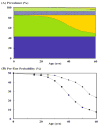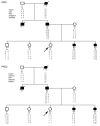Diagnosis and screening of autosomal dominant polycystic kidney disease
- PMID: 20219617
- PMCID: PMC2841025
- DOI: 10.1053/j.ackd.2009.12.001
Diagnosis and screening of autosomal dominant polycystic kidney disease
Abstract
Autosomal dominant polycystic kidney disease (ADPKD) is the most common inherited cause of kidney failure and accounts for approximately 5% of ESRD population in the United States. The disorder is characterized by the focal and sporadic development of renal cysts, which increase in size and number with age. Mutations of PKD1 and PKD2 account for most of the cases. Although the clinical manifestations of both gene types overlap completely, PKD1 is associated with more severe disease than PKD2, with larger kidneys and earlier onset of ESRD. In general, renal ultrasonography is commonly used for the diagnosis of ADPKD, and age-dependent criteria have been defined for subjects at risk of PKD1. However, the utility of the PKD1 ultrasound criteria in the clinic setting is unclear because their performance characteristics have not been defined for the milder PKD2 and the gene type for most test subjects is unknown. Recently, highly predictive ultrasound diagnostic criteria have been derived for at-risk subjects of unknown gene type. Additionally, both DNA linkage or gene-based direct sequencing are now available for the diagnosis of ADPKD, especially in subjects with equivocal imaging results, subjects with a negative or indeterminate family history, or in younger at-risk individuals being evaluated as potential living-related kidney donors. Here, we review the clinical utilities and limitations of both imaging- and molecular-based diagnostic tests and outline our approach for the evaluation of individuals suspected to have ADPKD.
2010 National Kidney Foundation, Inc. Published by Elsevier Inc. All rights reserved.
Conflict of interest statement
Figures




References
-
- Gabow PA. Autosomal dominant polycystic kidney disease. N Engl J Med. 1993;329:332–342. - PubMed
-
- Iglesias CG, Torres VE, Offord KP, Holley KE, Beard CM, Kurland LT. Epidemiology of adult polycystic kidney disease, Olmsted County, Minnesota: 1935-1980. Am J Kidney Dis. 1983;2:630–639. - PubMed
-
- Davies F, Coles GA, Harper PS, Williams AJ, Evans C, Cochlin D. Polycystic kidney disease re-evaluated: a population-based study. Q J Med. 1991;79:477–485. - PubMed
-
- Peters DJ, Sandkuijl LA. Genetic heterogeneity of polycystic kidney disease in Europe. Contrib Nephrol. 1992;97:128–139. - PubMed
-
- Dobin A, Kimberling WJ, Pettinger W, Bailey-Wilson JE, Shugart YY, Gabow P. Segregation analysis of autosomal dominant polycystic kidney disease. Genet Epidemiol. 1993;10:189–200. - PubMed
Publication types
MeSH terms
Grants and funding
LinkOut - more resources
Full Text Sources
Other Literature Sources
Medical
Miscellaneous

